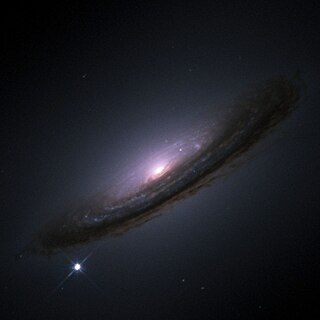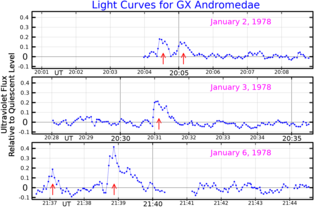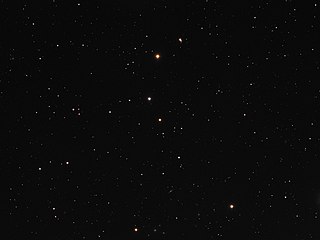Related Research Articles

A supernova is a powerful and luminous explosion of a star. A supernova occurs during the last evolutionary stages of a massive star, or when a white dwarf is triggered into runaway nuclear fusion. The original object, called the progenitor, either collapses to a neutron star or black hole, or is completely destroyed to form a diffuse nebula. The peak optical luminosity of a supernova can be comparable to that of an entire galaxy before fading over several weeks or months.
Ross 248, also called HH Andromedae or Gliese 905, is a small star approximately 10.30 light-years from Earth in the northern constellation of Andromeda. Despite its proximity it is too dim to be seen with the naked eye. It was first catalogued by Frank Elmore Ross in 1926 with his second list of proper-motion stars; on which count it ranks 261st in the SIMBAD database. It was too dim to be included in the Hipparcos survey. In about 40,000 years, Voyager 2 will pass 1.7 light-years from the star.

A super-luminous supernova is a type of stellar explosion with a luminosity 10 or more times higher than that of standard supernovae. Like supernovae, SLSNe seem to be produced by several mechanisms, which is readily revealed by their light-curves and spectra. There are multiple models for what conditions may produce an SLSN, including core collapse in particularly massive stars, millisecond magnetars, interaction with circumstellar material, or pair-instability supernovae.

Upsilon Andromedae is a binary star located 44 light-years from Earth in the constellation of Andromeda. The system consists of an F-type main-sequence star and a smaller red dwarf.

A blue supergiant (BSG) is a hot, luminous star, often referred to as an OB supergiant. They are usually considered to be those with luminosity class I and spectral class B9 or earlier, although sometimes A-class supergiants are also deemed blue supergiants.

Groombridge 34 is a binary star system in the northern constellation of Andromeda. It was listed as entry number 34 in A Catalogue of Circumpolar Stars, published posthumously in 1838 by British astronomer Stephen Groombridge. Based upon parallax measurements taken by the Gaia spacecraft, the system is located about 11.6 light-years from the Sun. This positions the pair among the nearest stars to the Solar System.

Delta Andromedae, Latinized from δ Andromedae, is a triple star system in the northern constellation of Andromeda. The system is visible to the naked eye as a point of light with a combined apparent visual magnitude of 3.28. Based upon parallax measurements, it is located at a distance of approximately 105.5 light-years from the Sun. The system is drifting closer with a radial velocity of −10 km/s.
11 Andromedae, abbreviated 11 And, is a single, orange-hued star in the northern constellation of Andromeda. 11 Andromedae is the Flamsteed designation. It has an apparent visual magnitude of 5.44, which is bright enough to be faintly visible to the naked eye. An annual parallax shift of 11.5 mas yields a distance estimate of 283 light years. It is moving further from the Earth with a heliocentric radial velocity of +10 km/s.

A Type Ia supernova is a type of supernova that occurs in binary systems in which one of the stars is a white dwarf. The other star can be anything from a giant star to an even smaller white dwarf.

Gliese 687, or GJ 687 (Gliese–Jahreiß 687) is a red dwarf in the constellation Draco. This is one of the closest stars to the Sun and lies at a distance of 14.84 light-years. Even though it is close by, it has an apparent magnitude of about 9, so it can only be seen through a moderately sized telescope. Gliese 687 has a high proper motion, advancing 1.304 arcseconds per year across the sky. It has a net relative velocity of about 39 km/s. It is known to have a Neptune-mass planet. Old books and articles refer to it as Argelander Oeltzen 17415.
The Hungarian Automated Telescope Network (HATNet) project is a network of six small fully automated "HAT" telescopes. The scientific goal of the project is to detect and characterize extrasolar planets using the transit method. This network is used also to find and follow bright variable stars. The network is maintained by the Center for Astrophysics | Harvard & Smithsonian.
Z Andromedae is a binary star system consisting of a red giant and a white dwarf. It is the prototype of a type of cataclysmic variable star known as symbiotic variable stars or simply Z Andromedae variables. The brightness of those stars vary over time, showing a quiescent, more stable phase and then an active one with a more pronounced variability and stronger brightening and/or dimming.

Tycho G has been proposed as the surviving binary companion star of the SN 1572 supernova event. The star is located about 6,400±1,500 light-years away in the constellation Cassiopeia. It is a subgiant, similar to the Sun in temperature, but more evolved and luminous.

RX Andromedae is a variable star in the constellation of Andromeda. Although it is classified as a dwarf nova of the Z Camelopardalis (UGZ) type, it has shown low-luminosity periods typical of VY Sculptoris stars. However, for most of the time it varies from an apparent visual magnitude of 15.1 at minimum brightness to a magnitude of 10.2 at maximum brightness, with a period of approximately 13 days.
Tau3 Eridani, Latinized from τ3 Eridani, is a star in the constellation Eridanus. It is visible to the naked eye with an apparent visual magnitude of 4.10. Using the parallax method, the distance to this star can be estimated as 88.6 light years. In 2001 it was reported as a candidate Vega-like star, meaning it appears to radiate an infrared excess from an orbiting circumstellar disk. However, this has not been confirmed.
In astronomy, a calcium-rich supernova is a subclass of supernovae that, in contrast to more well-known traditional supernova classes, are fainter and produce unusually large amounts of calcium. Since their luminosity is located in a gap between that of novae and other supernovae, they are also referred to as "gap" transients. Only around 15 events have been classified as a calcium-rich supernova – a combination of their intrinsic rarity and low luminosity make new discoveries and their subsequent study difficult. This makes calcium-rich supernovae one of the most mysterious supernova subclasses currently known.

EG Andromedae is a symbiotic binary in the constellation Andromeda. Its apparent visual magnitude varies between 6.97 and 7.80.

V455 Andromedae is a dwarf nova in the constellation Andromeda. It has a typical apparent visual magnitude of 16.5, but reached a magnitude of 8.5 during the only observed outburst.
References
- 1 2 3 Atlas of the Universe, "The Universe within 12.5 Light Years: The Nearest Stars", Richard Powell, 30 July 2006 (accessed 2010-11-01)
- 1 2 3 BBC News, "Hubble finds mass of white dwarf", Christine McGourty, 14 December 2005 (accessed 2010-11-01)
- ↑ W. J. Luyten (September 1944). "Note on the Double White Dwarf L 462-56 = LDS 275". Astrophysical Journal. 100: 202. Bibcode:1944ApJ...100..202L. doi:10.1086/144658.
- ↑ Schatzman, Évry (1958), White Dwarfs, North Holland Publishing Company, p. 2.
- ↑ Steinn Sigurdsson; Harvey B. Richer; Brad M. Hansen; Ingrid H. Stairs; Stephen E. Thorsett (July 2003). "A Young White Dwarf Companion to Pulsar B1620-26: Evidence for Early Planet Formation". Science. 301 (5630): 193–196. arXiv: astro-ph/0307339 . Bibcode:2003Sci...301..193S. doi:10.1126/science.1086326. PMID 12855802. S2CID 39446560.
- ↑ "Looking for planets around white dwarfs". Professor Astronomy. 20 August 2010.
- ↑ Hambsch, Franz-Josef. "Amateurs Help Discover Pulsing White Dwarf". Sky and Telescope.
- ↑ Jason Major (5 April 2013). "Hubble Spots the Most Distant Supernova Ever". Discovery Channel.
- ↑ "CANDELS Finds the Most Distant Type Ia Supernova Yet Observed". Cosmic Assembly Near-infrared Deep Extragalactic Legacy Survey (CANDELS). 23 April 2013.
- ↑ David O. Jones; Steven A. Rodney; Adam G. Riess; Bahram Mobasher; Tomas Dahlen; Curtis McCully; Teddy F. Frederiksen; Stefano Casertano; Jens Hjorth; Charles R. Keeton; Anton Koekemoer; Louis-Gregory Strolger; Tommy G. Wiklind; Peter Challis; Or Graur; Brian Hayden; Brandon Patel; Benjamin J. Weiner; Alexei V. Filippenko; Peter Garnavich; Saurabh W. Jha; Robert P. Kirshner; Henry C. Ferguson; Norman A. Grogin; Dale Kocevski (2 April 2013). "The Discovery of the Most Distant Known Type Ia Supernova at Redshift 1.914". The Astrophysical Journal. 768 (2) (published May 2013): 166. arXiv: 1304.0768 . Bibcode:2013ApJ...768..166J. doi:10.1088/0004-637X/768/2/166. S2CID 118890248. 166.
- 1 2 3 4 Lacki, Brian C.; Brzycki, Bryan; Croft, Steve; Czech, Daniel; DeBoer, David; DeMarines, Julia; Gajjar, Vishal; Isaacson, Howard; Lebofsky, Matt; MacMahon, David H. E.; Price, Danny C.; Sheikh, Sofia Z.; Siemion, Andrew P. V.; Drew, Jamie; Worden, S. Pete (2021-11-24). "One of Everything: The Breakthrough Listen Exotica Catalog". The Astrophysical Journal Supplement Series. 257 (2): 42. arXiv: 2006.11304 . Bibcode:2021ApJS..257...42L. doi: 10.3847/1538-4365/ac168a . ISSN 0067-0049.
- ↑ Universitaet Tübingen (24 November 2015). "The hottest white dwarf in the Galaxy". Science Daily.
- ↑ K. Werner; T. Rauch (29 September 2015). "Analysis of HST/COS spectra of the bare C–O stellar core H1504+65 and a high-velocity twin in the Galactic halo". Astronomy and Astrophysics. 584 (published December 2015): A19. arXiv: 1509.08942 . Bibcode:2015A&A...584A..19W. doi:10.1051/0004-6361/201527261. S2CID 118458007. A19.
- ↑ Sokoloski, J. L.; Kenyon, S. J.; Espey, B. R.; Keyes, Charles D.; McCandliss, S. R.; Kong, A. K. H.; Aufdenberg, J. P.; Filippenko, A. V.; Li, W.; Brocksopp, C.; Kaiser, Christian R.; Charles, P. A.; Rupen, M. P.; Stone, R. P. S. (2006-01-10). "A "Combination Nova" Outburst in Z Andromedae: Nuclear Shell Burning Triggered by a Disk Instability". The Astrophysical Journal. 636 (2): 1002–1019. arXiv: astro-ph/0509638 . Bibcode:2006ApJ...636.1002S. doi:10.1086/498206. ISSN 0004-637X. S2CID 8941207.
- 1 2 "A White Dwarf Living on the Edge". California Institute of Technology. 2021-06-30. Retrieved 2023-07-20.
- ↑ Sokoloski, J. L.; Kenyon, S. J.; Espey, B. R.; Keyes, Charles D.; McCandliss, S. R.; Kong, A. K. H.; Aufdenberg, J. P.; Filippenko, A. V.; Li, W.; Brocksopp, C.; Kaiser, Christian R.; Charles, P. A.; Rupen, M. P.; Stone, R. P. S. (2006-01-01). "A Combination Nova Outburst in Z Andromedae: Nuclear Shell Burning Triggered by a Disk Instability". The Astrophysical Journal. 636 (2): 1002–1019. arXiv: astro-ph/0509638 . Bibcode:2006ApJ...636.1002S. doi:10.1086/498206. ISSN 0004-637X.
- ↑ "New X-ray observations of the hot subdwarf binary HD 49798/RX J0648.0–4418". academic.oup.com. Retrieved 2023-01-08.
- 1 2 3 4 5 6 David Taylor (2012). "White Dwarf Stars Near The Earth" (PDF). The Life and Death of Stars. Weinberg College of Arts and Sciences - Northwestern University.
- 1 2 3 4 5 6 7 8 9 "White dwarfs within 10 parsecs". Sol Station. 2011.
- ↑ Caiazzo, Ilaria; Burdge, Kevin B.; Tremblay, Pier-Emmanuel; Fuller, James; Ferrario, Lilia; Gänsicke, Boris T.; Hermes, J. J.; Heyl, Jeremy; Kawka, Adela; Kulkarni, S. R.; Marsh, Thomas R.; Mróz, Przemek; Prince, Thomas A.; Richer, Harvey B.; Rodriguez, Antonio C. (2023-07-19). "A rotating white dwarf shows different compositions on its opposite faces". Nature. 620 (7972): 61–66. arXiv: 2308.07430 . Bibcode:2023Natur.620...61C. doi:10.1038/s41586-023-06171-9. ISSN 1476-4687.
- ↑ "Two-Faced Star Exposed". California Institute of Technology. 2023-07-19. Retrieved 2023-07-31.